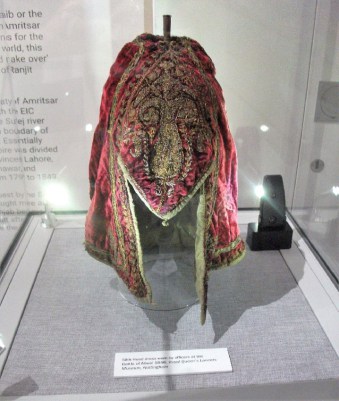
Anglo Sikh Wars exhibition review by the Military website:
Suburban Militarism!
My local museum is currently housing an exhibition dedicated to the Anglo-Sikh Wars 1845-1849. I’ve been a member of the Victorian Military Society since the age of 14 and so was naturally thrilled when I heard of this exhibition coming to my home city. Having been able to pay a visit to it today, I can say that it was well worth the anticipation.
Anglo-Sikh Wars Exhibition 2017: Battles, Treaties and Relics.
![]()
Leicester has a particularly close relationship with India, both historically and culturally. The Leicestershire Regiment was known as ‘the Tigers’ due to its lengthy service in India, and the city’s successful Rugby team is called the same. Today, the city of Leicester has one of the highest populations in the UK of people from the Indian subcontinent (including Sikhs) and these have contributed greatly to the city’s distinct cultural development into the 21st century. With these ties in mind, it makes Leicester an ideal venue for such an exhibition.
When the Anglo-Sikh Wars began, the Sikh army had been equipped and trained in the style of European armies of the time. A number of Napoleonic war veterans came over from Europe to assist ruler Ranjit Singh in creating a well-trained, well-equipped and well-paid fighting force. They were largely successful, but it still remained a European-Sikh hybrid as some of the army retained Sikh traditional dress, weapons and fighting methods due to cultural and religious resistance to the new ideas.
One of the first exhibits to catch my eye was this ‘foul weather’ czapka below from an officer of the 16th Lancers. The ‘foul weather’ aspect being presumably the black weather-proofing covering the headdress in favour of any other adornment or colour. The chain chinstrap could be unclipped from the back and then reapplied under the chin to a fixing on the side whenever necessary. The 16th Lancers won fame due to repeated charges made at the battle of Aliwal in the First Anglo-Sikh War. Here they successfully charged and broke the Sikh infantry squares which had been arrayed to receive cavalry in the European manner.
The next item of note was another example of military headdress. This wonderfully ornate cloth headpiece was ‘worn by officers at the battle of Aliwal’. Presumably, the curatorial staff are referring to the Sikh officers here, but it doesn’t specify which particular arm of the Sikh (or Khalsa) army. It might be a cavalry officer’s headpiece. Sikh cavalry consisted of a regular force trained in the European style of warfare, and a more irregular force known as the Gorchurra who were made up of the nobility and gentry of the Sikh kingdom. The Gorchurra resisted the European style military dress so I’m guessing that this fancy piece might be a feature of the Gorchurra?

One of the artefacts on display was already familiar to me as I’d seen it last year in Worcester during another Day Trip, it being on loan for this exhibition from the Mercian Regiment Museum there. A Sikh prince, or other high-ranking officer may well have worn this coat (below left and centre). The extremely detailed braiding at the back of the jacket could now be seen by me thanks to it’s relocation. It’s a terrific item and looks like it could easily be from the British army; albeit as a vastly more elaborate version than the peculiarly plain example worn by an officer of the 53rd regiment on the right.

Some battlefield relics I found particularly interesting, such as the piece of red cloth “cut from the sleeve of a Colour-sergeant of the 53rd Regiment mortally wounded on the battlefield of Sobraon Feb 10th 1846 and given at his request to Major Thomas Mowbray“. The scarlet still remains vivid against his sergeant’s stripe even to this day.
This Sikh artilleryman’s sword was another battlefield relic, the inscription on the blade records how it was found lying close the body of a cornet in the 16th Lancers after the battle of Aliwal, 1846.Anglo sikh wars exhibition.
Not all battlefield relics were of a military nature, though. A British officer’s bible taken into the battle of Chillianwallah was on display as was this Sikh manuscript was found at the battle of Ferozeshah. The item contained compositions by Guru Granth Sahib and Sri Dasam Granth Sahib. Lying below it can be seen two sharp circular Sikh Chakkars (war quoits) and deadly-looking Tulwars (swords) taken during the wars.

Below can be seen two British army swords, the larger being an infantry officers sword. The smaller is an 1821 pattern Light Cavalry Sabre as used by a Sergeant in the 16th Lancers. The exhibition included reports of how inferior the blunt British cavalry sabres were when compared to the razor-sharp Sikh versions.
Anglo sikh wars exhibition.

There were a number examples of hand-drawn maps on display, these were sketches of battlefield and siege dispositions. I was also pleased to see reproductions of contemporary paintings on the war a number of which were by the artist Henry Martens depicting actions at the battles of Ramnuggur, Sobraon, Mudki and Aliwal. The artist Henry Martens could even possibly be a source for a later post, I think.
 “The 62nd Regt on the 2nd Day of Ferozeshah” by Henry Martens
“The 62nd Regt on the 2nd Day of Ferozeshah” by Henry Martens
Congratulations are to go to the Sikh Museum Initiative, The Newarke Houses Museum and the many others involved in making this exhibition happen. It remains on until the 4th July 2017 and comes very well recommended by Suburban Militarism!
Original story can be seen on the Suburban Militarism website.
